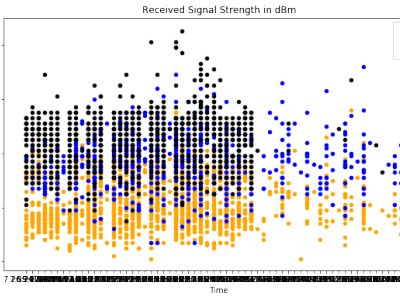Communications
This data presents the Reference Signal Received power for LTE, GSM and HSPA. The Mobile signal measurement were taken around Covenant University, Nigeria. The experiment setup was on an indoor scenario. The data was collected to investigate the best network for Mobile subscribers on roaming services and local subscriber's high performance and data rates.
- Categories:
 1924 Views
1924 ViewsThe dataset contains:
1. We conducted a A 24-hour recording of ADS-B signals at DAB on 1090 MHz with USRP B210 (8 MHz sample rate). In total, we got the signals from more than 130 aircraft.
2. An enhanced gr-adsb, in which each message's digital baseband (I/Q) signals and metadata (flight information) are recorded simultaneously. The output file path can be specified in the property panel of the ADS-B decoder submodule.
3. Our GnuRadio flow for signal reception.
4. Matlab code of the paper, wireless device identification using the zero-bias neural network.
- Categories:
 3547 Views
3547 Views
Exact BER Analysis for Two-user NOMA uUing QAM with Arbitrary Modulation Order
- Categories:
 680 Views
680 Views
There has been extensive modelling of the optical wireless channel, and the optimum modulation scheme for a particular channel is well-understood. However, this modelling has not taken into account the trade-offs that transmitter and receiver selection usually involve. For a particular type of transmitter, the modulation bandwidth and available power are closely related, as are receiver bandwidth, active area and sensitivity. In this paper, we present a design approach that takes this device selection into account.
- Categories:
 215 Views
215 ViewsOne-way delay (OWD) is the transmission time of the network packet from the first to the last bit from the sender node to the receiver node. The data set presented here was obtained as a result of measurements performed for the paper “Improving the Accuracy of One-Way Delay Measurements”.
One-way delay measurements were performed using three different utilities:
* the utility from the OWAMP protocol;
* first version of our utility, owping1; and
* the new version of our utility, owping2.
- Categories:
 994 Views
994 Views
The following data set is modelled after the implementers’ test data in 3GPP TS 33.501 “Security architecture and procedures for 5G System” with the same terminology. The data set corresponds to SUCI (Subscription Concealed Identifier) computation in the 5G UE (User Equipment) for IMSI (International Mobile Subscriber Identity) based SUPI (Subscription Permanent Identifier) and ECIES Profile A.
- Categories:
 7465 Views
7465 Views
Secure cryptographic protocols are indispensable for modern communication systems. It is realized through an encryption process in cryptography. In quantum cryptography, Quantum Key Distribution (QKD) is a widely popular quantum communication scheme that enables two parties to establish a shared secret key that can be used to encrypt and decrypt messages.
- Categories:
 165 Views
165 Views



